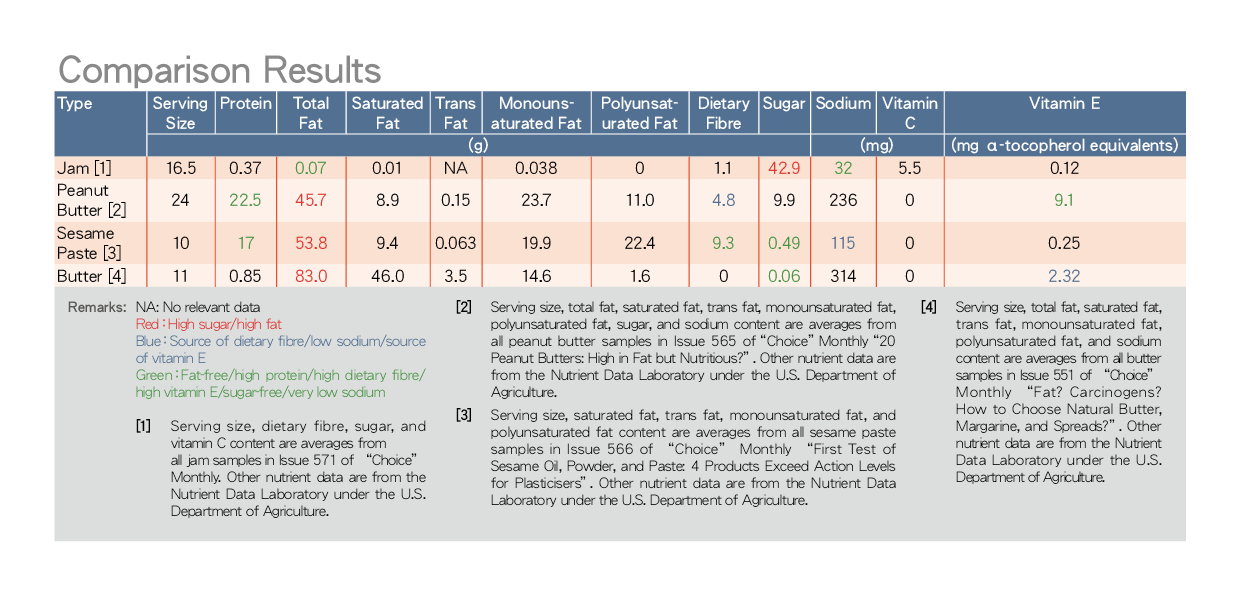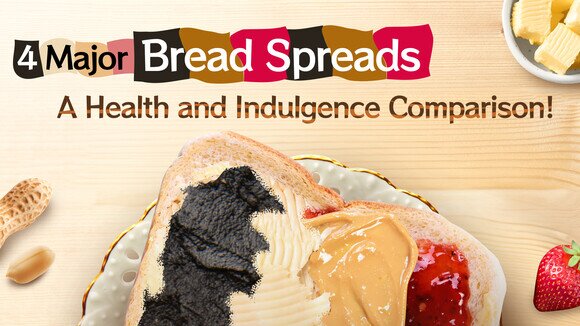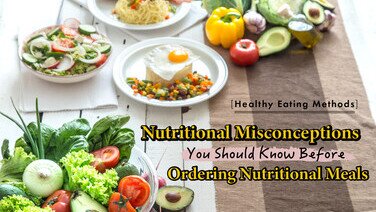Comparison Results

Protein Comparison: Peanut Butter and Sesame Paste Win
Protein helps build muscles and repair cells and tissues. According to the Nutrient Data Laboratory under the U.S. Department of Agriculture, peanut butter and sesame paste samples contain an average of 22.5 grams and 17 grams of protein per 100 grams, respectively, making them “high-protein” foods.
In contrast, the protein content of jam and butter is relatively low, with samples containing only 0.37 grams and 0.85 grams of protein per 100 grams, respectively.
Fat Comparison: Jam Wins
Fat provides energy and essential fatty acids for the body, helping to absorb fat-soluble vitamins. However, excessive intake can lead to obesity. Excessive saturated fatty acids increase bad cholesterol in the blood, affecting heart health. Trans fatty acids increase bad cholesterol levels while lowering good cholesterol levels, having a greater impact on the body than saturated fatty acids. Long-term intake of large amounts of trans fatty acids can increase the risk of cardiovascular diseases. Although monounsaturated and polyunsaturated fatty acids can lower bad cholesterol levels in the blood and reduce the risk of cardiovascular diseases, excessive intake can also lead to obesity.
According to the U.S. Department of Agriculture Food Data Center, jam has an average total fat content of 0.07 grams, making it a “fat-free” food. In contrast, tests found that peanut butter, sesame paste, and butter are “high-fat” foods. According to test results and the U.S. Department of Agriculture Food Data Center, butter has the highest average total fat content (83.0 grams per 100 grams), followed by sesame paste (53.8 grams) and peanut butter (45.7 grams). Butter’s fat is mainly saturated fat (46.0 grams), and its trans fat (3.5 grams) is the highest among the four spreads. Peanut butter’s fat is mainly monounsaturated fat (23.7 grams). Sesame paste has a balanced distribution of monounsaturated and polyunsaturated fats, with average contents of 19.9 grams and 22.4 grams, respectively.
Dietary Fibre Comparison: Sesame Paste Wins
Increasing dietary fibre intake helps reduce body fat and is associated with a lower risk of cardiovascular diseases, type 2 diabetes, and cancer.
According to test results and the Nutrient Data Laboratory under the U.S. Department of Agriculture, peanut butter has an average dietary fibre content of 4.8 grams per 100 grams, making it a “source of dietary fibre.” Sesame paste, with an average dietary fibre content of 9.3 grams per 100 grams, is a “high dietary fibre” food.
In contrast, although jam is made from fruit, its average dietary fibre content is only 1.1 grams, not qualifying as a “source of dietary fibre.” Butter samples contain no dietary fibre at all.
Sugar Comparison: Butter and Sesame Paste Win
Excessive intake of free sugars can increase the risk of obesity, diabetes, and tooth decay.
According to test results and the U.S. Department of Agriculture Food Data Center, butter and sesame paste are “sugar-free” foods, with average sugar contents of 0.06 grams and 0.49 grams per 100 grams, respectively.
Peanut butter has an average sugar content of 9.9 grams per 100 grams, not qualifying as “high sugar,” “low sugar,” or “sugar-free” food.
In contrast, jam is a “high sugar” food. Although its total fat content is low, its sugar content is the highest among the four, with an average of 42.9 grams per 100 grams.
Sodium Content Comparison: Jam and Sesame Paste Win
An appropriate amount of sodium is essential for maintaining normal body functions, but excessive intake can increase the risk of high blood pressure, which, if not treated early, can lead to chronic diseases such as heart disease and stroke.
According to test results and the U.S. Department of Agriculture Food Data Center, jam samples have the lowest average sodium content (32 milligrams per 100 grams), making them “very low sodium (or salt)” foods. Sesame paste follows with a sodium content of 115 milligrams, making it a “low sodium (or salt)” food.
Vitamin C Comparison: No Winner
Vitamin C is a water-soluble vitamin that helps wound healing, maintains joint health, and aids iron absorption to prevent anaemia. Insufficient intake can lead to scurvy, swollen and bleeding gums, and joint pain.
According to test results and the U.S. Department of Agriculture Food Data Center, only jam was found to contain vitamin C. However, the average vitamin C content per 100 grams is only 5.5 milligrams, so it is not considered a “source of vitamin C.” The other three spreads did not contain vitamin C.
Vitamin E is a fat-soluble vitamin with antioxidant properties, protecting cell membranes from free radical damage.
According to the U.S. Department of Agriculture Food Data Center, peanut butter and butter have average vitamin E contents of 9.1 mg α-tocopherol equivalents and 2.32 mg α-tocopherol equivalents per 100 grams, respectively, making them “high vitamin E” and “source of vitamin E” foods.
Eat Less, Enjoy More: Balanced Diet is More Important
Although the above four spreads each have unique flavours and benefits, it is important to remember to reduce the intake of sugar, sodium, saturated fats, and trans fats. A balanced diet is always the most important! It is recommended to eat at least two servings of fruit and three servings of vegetables daily.
Disclaimer
This article has been translated using artificial intelligence (AI) technology. While efforts have been made to ensure the accuracy of the translation, it may not be perfect and could contain errors or inaccuracies. The original article at https://www.consumer.org.hk/tc/shopping-guide/features/2024-jam should be referred to for the most accurate information. The Consumer Council does not assume any responsibility for any error, omission, or ambiguity in the translated content. If you have any question or concern about the translation, please refer to the original article or consult a professional translator.




![[Baby Snacks Guide] Who Says Snacks Can’t Be Healthy?](/f/guide_detail/415742/376c212/bb%20snack.jpg)






